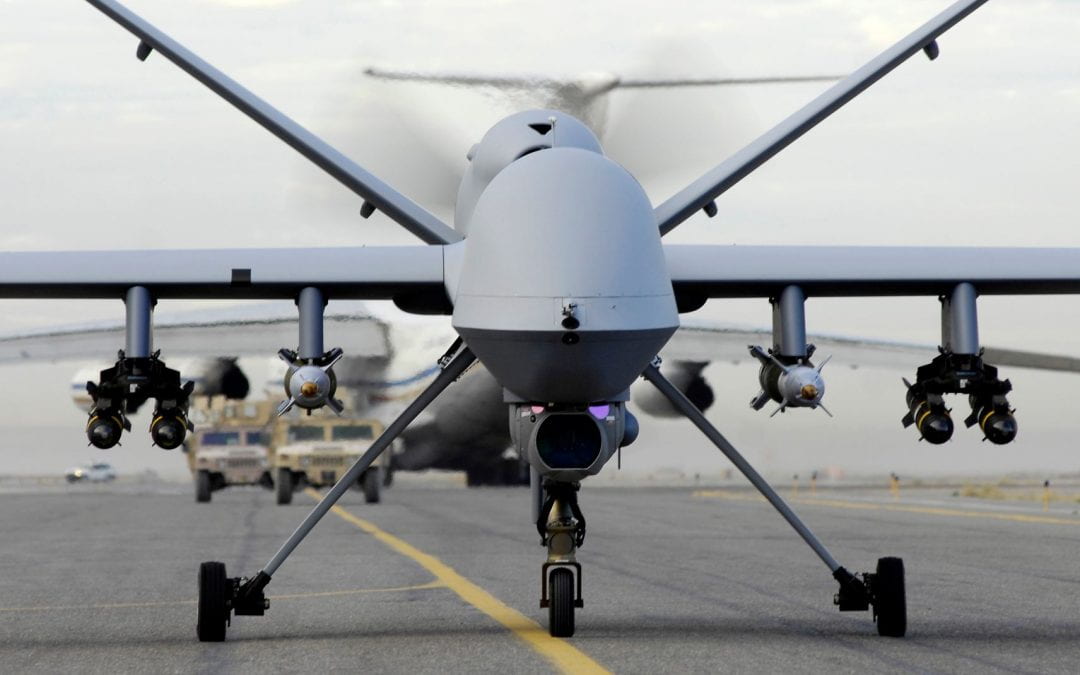By Ben Goldson
According to a new study, the use of Unmanned Aerial Vehicles in combat has worked to normalise the practice of targeted assassinations.
According to a study titled “In the Frame,” commissioned by advocacy group, Drone Wars, the use of Unmanned Aerial Vehicles in combat has worked to normalise the previously taboo practice of targeted assassinations. Central to this practice is the fight against the organisation that calls itself the Islamic State by a coalition of the United States and the United Kingdom. Authored by Drone Wars researcher and International Relations Professor Dr Joanna Frew, “In The Frame” records the data of four outlets, from The Guardian through BBC News and The Times to the Daily Mail, in a time period that begins with the death of British national Reyaad Khan. Dr Frew finds that much of the coverage of targeted assassinations took place in the immediate aftermath of individual cases such as Khan’s, itself responsible for more than a third of stories published in the time period, as opposed to general discussion in more sober moments. Moreover, the amount of coverage resulting from these individual strikes trended downwards after Khan, aside from an outlier in the death of Mohammed “Jihadi John” Emwazi.
Drawing on these results, “In The Frame” argues an increasing acceptance of the once controversial tactic has enabled the government to maintain its policy, or lack thereof, on targeted assassinations, further contesting that this makes it difficult for groups such as Drone Wars to challenge the legality of the strikes. Of the four outlets, The Guardian was found to have been the most critical of the government’s justification, with the highest amount of commentary that suggests the killings are illegal. After it came The Times, which also carries more critical analysis, although “In The Frame” notes that the ratio with supportive commentary is significantly closer than The Guardian’s, and that the Conservative-leaning paper’s editorial line is broadly supportive of the government. The remaining two outlets, despite their ideological differences, both carried more statements supporting the legality of the strikes, with Dr Frew singling out BBC News for failing to live up to its mandate to be independent of all, including the state that funds it. In contrast, the Daily Mail’s enthusiasm for the policy reflects its editorial line and has published the supposed account of an anonymous soldier working in a unit tasked with overseeing a “kill list” of British nationals who left to fight for ISIS.
The story caused a brief resurgence of interest in the list, whose reputed existence was discussed with relative frequency in the aftermath of Reyaad Khan’s death only to once again fade from the headlines over the course of the study. What is unique, however, is that interest in what appeared to be proof that the list did exist cut across partisan lines, with The Guardian being the only other one of the four to cover it, although for different reasons. Whereas The Guardian, broadly speaking, shares the concerns of groups such as Drone Wars, the Daily Mail welcomed the news, to the point where it published the unnamed soldier’s account in defiance of the government’s official policy. Swiftly denied by a spokesperson from the Ministry of Defence, the story still highlighted the division between outlets, and presumably readers, who support the strikes. In contrast to the Mail, The Times, which is ostensibly expected to maintain norms of neutrality, employed legalistic rhetoric to defend a similar coverage.
These dueling themes, which might be thought of as pay-back and self-defence, were touched upon by Boris Johnson in a 2018 Spectator column, which marks the end of the time period studied by “In The Frame.” The recently resigned Foreign Minister claimed in the piece that the official argument for the assassinations “scarcely masks the reality” of the true situation, providing a legal veneer for the desire to exact retribution on the targeted. As Prime Minister, Johnson was largely supportive of the United States in the aftermath of Qasem Soleimani’s death, calling for a general de-escalation of tensions while also labelling the deceased a “threat” in comments repeated by the new Foreign Minister Dominic Raab. This was likely a reference to Soleimani’s work as head of the Revolutionary Guard, with its alleged support for Shia militia groups in Iraq that fought UK troops following the 2003 invasion, aligning the deceased with the ISIS fighters already eliminated in similar circumstances.
In a study cited by “In The Frame,” Andris Banka and Adam Quinn concluded that in post-9/11 America, established norms against intelligence agencies singling people out for assassination had effectively ceased to exist. While critics could point out that nation-states, from the United States and the United Kingdom to their Iranian rivals, are believed to have long attempted to subvert these norms with covert operations, the key difference is that there is no attempt, however small, to distance oneself from the act of killing. As in the case of Soleimani, the brazen nature of the assassinations may put pressure on the other side to respond in lieu of appearing weak, with the Iranian Revolutionary Guards Corps firing off a number of missiles at Iraqi air bases from which they claimed the attack on their dead leader had originated. The news heightened alarm over the prospect of further escalation, all stemming from the kind of targeted assassination, which had become a largely accepted feature of the war against ISIS.
Ben Goldson is a news and current affairs broadcaster at 95bFM radio in Auckland.
Disclaimer: The ideas expressed in this article reflect the author’s views and not necessarily the views of The Big Q.
You might also like:
Was the killing of Qasem Soleimani legal under international law? 🔊

